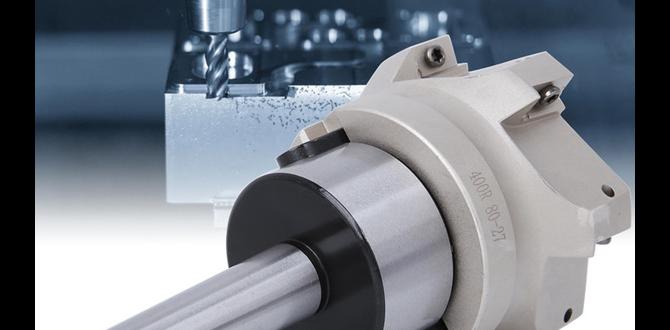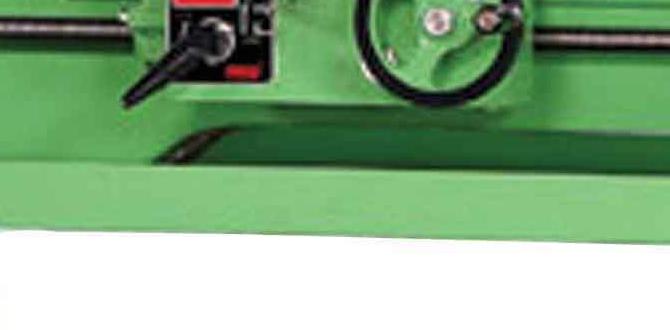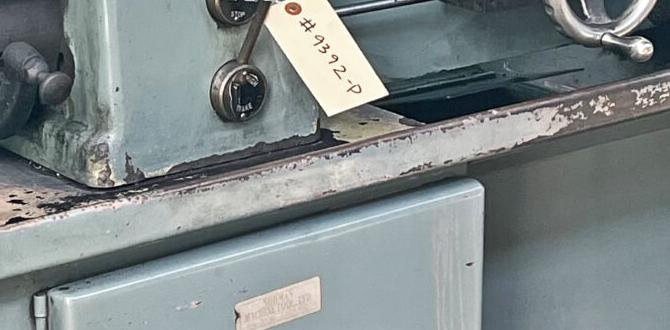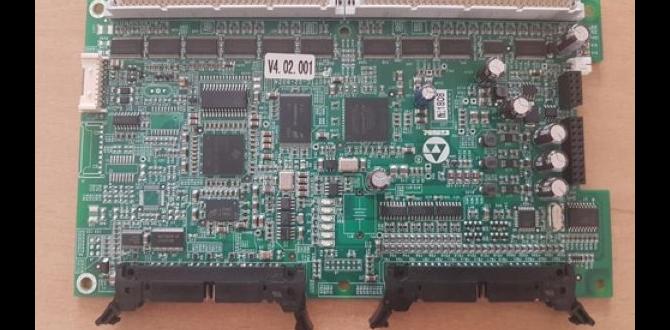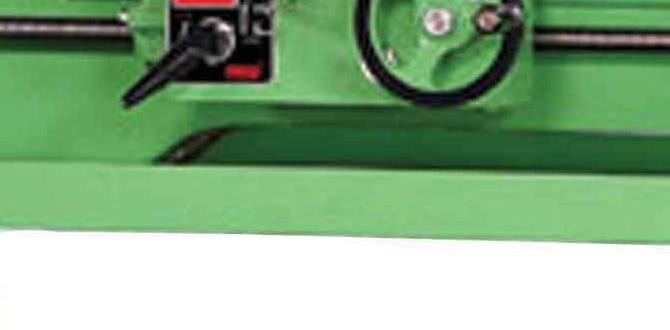Yes, you can build a brilliant, homemade wood lathe sharpening wheel that makes your turning tools razor-sharp and ready for action, saving you money and boosting your woodworking confidence. This guide breaks it down into simple steps!
Welcome to Lathe Hub! If you love turning wood, you know how frustrating it is when your tools get dull. It makes everything harder and can even be a bit dangerous. Buying expensive sharpening systems can feel overwhelming when you’re just starting out. But what if I told you that you could create a highly effective sharpening wheel right in your own workshop? It’s not as complicated as it sounds! We’re going to walk through building a “genius essential” for any wood turnér – a homemade wood lathe sharpening wheel. Get ready to bring your chisels and gouges back to life!
Why a Homemade Sharpening Wheel?
Keeping your wood lathe tools sharp is non-negotiable for good woodworking. Dull tools tear at the wood, produce fuzzy finishes, and require more pressure, which can lead to slips and accidents. While commercial sharpening systems are great, they can be pricey. A well-made homemade sharpening wheel offers a fantastic alternative for hobbyists and home workshop enthusiasts who want professional results without the professional price tag. It’s an investment in your tools and your craft that quickly pays for itself.
Think about it: you can tailor it to your specific needs, learn a new skill in the process, and have the satisfaction of knowing you built it yourself. Plus, when those chisels and gouges are screaming sharp, your work will be smoother, your cuts cleaner, and your overall turning experience much more enjoyable and safer.
Understanding the Basics: What Makes a Sharpening Wheel Work?
At its core, a sharpening wheel is a rotating abrasive surface. As your tool comes into contact with this surface, the abrasive material grinds away minuscule amounts of metal, restoring the keen edge of your cutting tool. For wood lathe tools, especially those made of high-speed steel (HSS), a slightly lower grit abrasive is typically used, often combined with a honing compound for a final polished edge.
The key elements are:
- The Wheel Itself: This is the abrasive component. It can be a dedicated grinding wheel, a spoked wheel with abrasive cloth, or a specially designed grinding surface.
- The Motor: A motor provides the rotation. For our homemade project, we’ll aim for a speed that’s effective for sharpening without overheating the tool.
- The Mount/Stand: This holds the wheel securely and often includes a rest or jig for presenting the tool at the correct angle.
- Safety Features: Eye protection and guards are absolutely vital for any spinning abrasive.
Choosing Your Approach: Different Homemade Sharpening Wheel Designs
There are a few popular ways to approach building a homemade sharpening wheel. Each has its pros and cons, and the best choice for you will depend on the materials you have available and your comfort level with DIY projects.
Option 1: The “Dressed-Up” Grinding Wheel
This method involves taking a standard grinding wheel (often a slower-speed, coarser grit wheel designed for tool sharpening) and adding a honing compound. Grinding wheels can be brittle, so safety is paramount here. You’d typically mount this on a dedicated grinder or a sturdy base with a motor.
Option 2: The Abrasive Wheel with a Backing
This is often a more accessible and safer method for home builders. You use a sturdy disk (like plywood or a metal plate) and glue abrasive grit or abrasive cloth onto it. This allows for more control over the grit and the finish.
Option 3: The Buffing Wheel with Abrasive Compound
For a polishing and honing step, a buffing wheel with a specific sharpening compound is excellent. This is less about heavy material removal and more about refining the edge to a razor-sharp finish. It can be used standalone for very minor touch-ups or as the final stage after grinding.
For this guide, we’ll focus on a robust and effective design using Option 2 – an abrasive wheel with a backing, as it offers a great balance of performance, cost, and buildability for beginners.
Project Overview: Building Your Own Abrasive Sharpening Wheel
Let’s get down to building a sharpening wheel that delivers excellent results. We’ll aim for a versatile wheel that can handle most of your wood lathe tool sharpening needs. This project assumes you have some basic DIY skills and access to common workshop tools.
Materials You’ll Need
Gathering your materials is the first crucial step. Having everything ready before you start will make the process much smoother.
- Wheel Base: A sturdy, flat disk. 6-inch to 10-inch diameter is a good starting point. Options include:
- 3/4-inch Baltic Birch Plywood (or other strong plywood)
- A solid metal disk (e.g., aluminum, steel – if you have access to metalworking tools)
- Abrasive Material: Flexible abrasive cloth or paper (like emery cloth or Silicon Carbide sandpaper). Grits: 120-180 for initial shaping, 220-320 for refining the edge, and possibly a finer grit (400-600) for a keen finish. You can also use PSA (Pressure Sensitive Adhesive) sandpaper cut into strips or circles.
- Adhesive: A strong, flexible glue. Contact cement (like DAP Weldwood) or a good quality wood glue are excellent choices. Ensure it’s designed for bonding abrasive to backing.
- Motor: A suitably powered electric motor. A 1/2 HP to 1 HP motor is usually sufficient. A repurposed washing machine motor or a dedicated grinder motor can work. Or, if you have a variable-speed wood lathe, you can potentially adapt it to hold the wheel.
- Shaft/Arbor: To connect your wheel to the motor. This might be a keyed shaft, a threaded rod, or a bolt depending on your motor and wheel design.
- Bearings/Housing (Optional but Recommended): If you’re building a standalone unit, bearings will ensure smooth rotation and longevity.
- Mount/Stand: Sturdy material like wood (2x4s, 4x4s) or metal to build a stable base and support for the motor and wheel.
- Tool Rest: A metal or wooden piece to support your tool as you sharpen. Adjustable is ideal.
- Hardware: Bolts, nuts, washers, screws for assembly.
- Dressing Stick or Diamond Plate (Optional): For cleaning and truing the abrasive surface.
- Eye Protection: Safety glasses or a face shield (ESSENTIAL!).
- Dust Collection/Mask: For sanding and grinding.
Tools You’ll Need
Make sure you have these on hand:
- Jigsaw or Bandsaw (for cutting the wheel base)
- Drill and drill bits
- Screwdrivers
- Wrenches or socket set
- Clamps
- Sandpaper (for preparing surfaces)
- Scissors or utility knife (for cutting abrasive cloth)
- Measuring tape or ruler
- Pencil
- Safety gloves
Step-by-Step Construction Guide
Let’s build this! Remember, safety first. Always wear your eye protection.
Step 1: Prepare the Wheel Base
Cut your chosen material (plywood or metal) into a perfect circle. A 6-inch diameter is a good starting point for many chisels and smaller gouges. You can use a compass to draw it on your material and then cut it with a jigsaw or bandsaw. If using plywood, ensure the grain direction is consistent for strength. Drill a central hole that precisely fits your motor shaft or arbor. Make sure this hole is perfectly centered for a wobble-free rotation.
Step 2: Prepare the Abrasive Material
Cut your abrasive cloth or sandpaper into strips or a large circle that will cover your wheel base. If using cloth, cut it slightly wider than the width of your wheel to allow for overlap when wrapping. If using sandpaper, you can cut it into strips to form concentric circles or one large circle. For a more durable wheel, consider using abrasive cloth designed for belt sanders or by the yard.
Step 3: Apply the Adhesive and Abrasive
This is a critical step for durability.
- For Contact Cement: Apply a thin, even coat of contact cement to both the wheel base and the back of the abrasive material. Let both surfaces become tacky (follow manufacturer instructions). Carefully position the abrasive and press it firmly onto the wheel base, working from the center outwards to eliminate air bubbles.
- For Wood Glue: Apply a generous but even layer of wood glue to the wheel base. Lay down your abrasive material and clamp it firmly to the wheel, perhaps using large cans or weights on the surface, and let it cure completely (this can take 24 hours).
If you’re using strips, work methodically, overlapping them slightly as you wrap or lay them on the wheel. For a continuous surface, ensure there are no gaps. If using PSA sandpaper, simply peel off the backing and adhere it carefully, again working out air bubbles. Trim any excess abrasive cleanly around the edge of the wheel.
Step 4: Mount the Motor and Wheel
Build a sturdy stand or enclosure for your motor. This needs to be stable and strong enough to handle the motor’s vibration. Mount the motor securely to the stand. Affix the wheel to the motor shaft or arbor. Ensure it’s a tight, secure fit. If using a keyed shaft, use the key. If using a threaded rod or bolt, use locking nuts and washers. Double-check that the wheel runs true and doesn’t wobble.
Step 5: Construct a Tool Rest
A solid tool rest is essential for presenting your tools at a consistent angle against the wheel. You can fashion a simple one from wood (e.g., a block with a slot or a shaped piece) or metal. For best results, make it adjustable so you can set different angles for bevels. Mount the tool rest so that it’s solid, vibration-free, and positioned correctly relative to the abrasive surface for comfortable use.
Step 6: Safety First – Install Guards and Test
Before you even think about turning it on, ensure you have comprehensive safety measures.
- Eye Protection: Always wear safety glasses or a face shield.
- Enclosure: If possible, create a simple shroud or guard around the wheel to contain dust and any potential debris.
- Stable Base: Make sure the entire unit is stable and won’t tip over.
- Location: Position it in a well-lit area with good ventilation.
Plug in the motor and let it run for a few minutes. Listen for any unusual noises and watch for excessive vibration. If everything sounds and feels okay, it’s time for a test sharpening.
Using Your Homemade Sharpening Wheel
Now comes the fun part – putting your new sharpening wheel to work! Consistent technique is key here.
Sharpening Wood Lathe Chisels and Gouges
Step 1: Select the Right Grit
For dull or damaged tools, start with a coarser grit (120-180). For tools that just need a touch-up, a medium grit (220-320) is perfect. For a final polish, you might use a finer grit in conjunction with a honing compound.
Step 2: Set Up Your Tool Rest
Position the tool rest so it supports the bevel of your tool. The angle you set is crucial for replicating the original geometry of the cutting edge. A common angle for many chisels and gouges is around 30-40 degrees, but check what’s recommended for your specific tool.
Step 3: Present the Tool
Hold the tool firmly with both hands. Bring the bevel into gentle contact with the spinning abrasive wheel. Move the tool back and forth in a sweeping motion, ensuring you sharpen the entire bevel evenly. Don’t press too hard; let the abrasive do the work. The goal is to remove metal and create a fresh, sharp edge.
Key Tips:
- Keep it Cool: Overheating the tool can damage the temper of the steel, making it softer and less able to hold an edge. If the tool feels hot to the touch, stop and let it cool, or dip it in water.
- Sharpen Both Sides Evenly: If you are sharpening a chisel with two bevels, ensure you alternate sides to maintain symmetry. For gouges, you’ll likely be working along the flute.
- Follow the Angle: Try to maintain the same angle throughout the sharpening process. This is where a fixed or adjustable tool rest is invaluable.
- Check for a Burr: As you sharpen, a small burr (a slight raised edge of metal) will form on the opposite side of the bevel you are sharpening. This indicates you’ve reached the edge.
Step 4: Refine the Edge (Honing)
Once you’ve established a sharp edge on the grinding wheel, you’ll want to hone it. This can be done on a finer grit wheel (400-600) or, even better, on a buffing wheel loaded with a sharpening or honing compound. A dedicated honing wheel (often softer and designed for this purpose) is ideal. For many woodworkers, a leather strop with polishing compound is the final step after sharpening.
Step 5: Honing Compound Application
Apply a light coating of honing compound to your refining wheel or buffing wheel. Drag the bevel of your tool across this surface, again maintaining the correct angle. This removes any microscopic burrs or imperfections left by the grinding wheel, leaving you with an incredibly sharp, polished edge. A few light passes are usually sufficient.
Sharpening Scrapers
Scrapers often have a small burr or “hook” on their cutting edge. You typically sharpen them by grinding the side at a slight angle (around 45 degrees) and then turning that burr with a burnisher. A fine grit on your homemade wheel can prepare the edge for burnishing.
Sharpening Other Turning Tools
The principles remain the same for other tools like parting tools, skew chisels, and V-tools. Identify the cutting edge, determine the correct bevel angle, and present it to the abrasive surface, moving to refine the edge without overheating.
Maintenance and Care for Your Sharpening Wheel
To ensure your homemade sharpening wheel remains effective and safe, regular maintenance is key.
Truing and Cleaning the Wheel
Over time, the abrasive surface can become loaded with metal particles or glaze over, reducing its effectiveness.
- Dressing: Use a grinding wheel dresser or a piece of scrap hardened steel (like an old file) held against the spinning wheel to break away loaded material and expose fresh abrasive. A diamond plate can also be used.
- Cleaning: Sometimes, a stiff brush can remove loose debris.
Regular truing will keep your wheel cutting effectively and prevent uneven wear.
Replacing Abrasive Material
When the abrasive no longer cuts effectively, it’s time to replace it. Carefully remove the old material (you might need a solvent if it was glued with contact cement) and apply new abrasive as you did during the initial build.
Checking the Motor and Mount
Periodically inspect the motor, shaft, and mount. Ensure belts are tight (if applicable), bearings are lubricated, and all connections are secure. Listen for any changes in motor sound or vibration that might indicate a problem.
Pros and Cons of a Homemade Wood Lathe Sharpening Wheel
Like any DIY project, there are trade-offs.
| Pros | Cons |
|---|---|
| Cost-effective compared to commercial units. | Requires DIY skills and access to tools/materials. |
| Customizable to your needs and tool types. | Safety knowledge and implementation are critical. |
| Satisfying and rewarding to build. | May not have the precision or consistency of high-end machines. |
| Helps you understand tool geometry better. | Maintenance and repair are your responsibility. |
| Empowering for self-sufficiency in the workshop. | Initial setup time investment. |
Safety Considerations: A Priority Above All Else
I cannot stress this enough: safety is paramount when working with any rotating machinery, especially abrasive wheels.
- Eye Protection is Non-Negotiable: Always wear ANSI-approved safety glasses or a full face shield. Grinding wheels can shatter, and debris can fly off.
- Dust Control: Wood dust and metal dust can be harmful. Use a dust mask or respirator and consider dust collection if possible.
- Guarding: Ensure your wheel is adequately guarded to prevent accidental contact or containing a potential wheel failure.
- Stability: The entire unit must be stable and secured.


